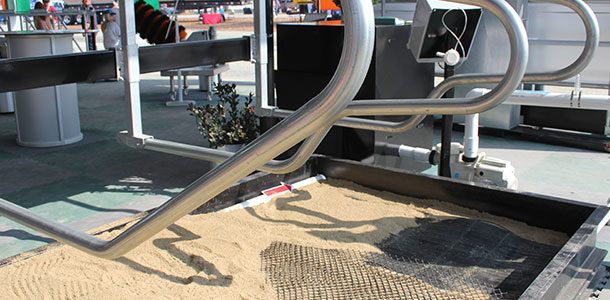This article was #19 of the Top 25 most well-read articles on www.progressivedairy.com in 2014. It was published in the April 11, 2014 Extra e-newsletter. GEA Farm Technologies introduced conductive cooling at World Ag Expo earlier this year. The technology included heat exchanger panels buried underneath the sand in deep-bedded freestalls.
Cooled water circulates through the closed-loop system, providing heat stress relief to cows as they are lying in the stalls. This concept has the potential to save on both water and energy usage on dairies. While fans are still a necessary component of the heat abatement system, this allows for more targeted energy use.
We asked a company rep,
Q. When the article was written, there were plans to install several of these systems later on in the year and for it to be commercially available in late 2014. What is the status as of now?
In 2014 we updated the design on our heat exchanger panel to optimize the water flow rate and assist in an easier installation process. The panels were installed on our test farm and the initial results are very positive. Further testing will continue during the summer of 2015. We have received a large amount of interest from dairy producers in North America and around the world. Additional installations are planned prior to full commercial release.
—Eric Moscho, GEA Farm Technologies
:
Fans, foggers, soakers and misters … dairymen go to great lengths to keep cows cool. While these cooling methods work from the top down, a new concept works from the bottom up.
Conductive cooling is basically the transfer of heat to cold between a warm surface and a cool surface, explains Eric Moscho, U.S. national sales manager for barn equipment, GEA Farm Technologies Inc. The company introduced its solution for conductive cooling at World Ag Expo in Tulare, California, earlier this year.
“We are putting the cooling where we want the cow to be,” Moscho says. This closed loop system does just that. It delivers a cooling effect to the cow while she is lying in the stall, moving heat away from her body at the point of contact.
So, how does it work?
In a deep-bedded free stall, a heat exchanger panel is buried at a depth of 8 to 10 inches. Water flows through the chambers of the exchanger, which are made from a durable, high-density plastic. Depending on the temperature of the ground water, it may have to pass through a chiller before circulating through the system. Cooled water consistently and evenly flows through the chambers underneath the cow, thus carrying away the cow’s body heat to cool her.
 “The idea of having the cooling source in the bed is intriguing because it is where we want the cow to be the majority of the day,” Moscho adds.
“The idea of having the cooling source in the bed is intriguing because it is where we want the cow to be the majority of the day,” Moscho adds.
While fans and sprinklers over the feed bunk are helpful, they also provide heat abatement for the six to eight hours the cows spends eating per day; ideally, she will be laying down for 10 to 12 hours.
Like other cooling systems, conductive cooling is based on the thermal neutral index. Because heat stress can begin to affect dairy cows at temperatures as low as 68 degrees Fahrenheit (depending on humidity), it can be programmed to operate at a set trigger point.
Moscho sees potential for conductive cooling to be more than a cow comfort solution; it addresses some of the other major challenges facing dairies.
“This is a way to reduce water usage in agriculture,” he adds. “Every producer we work with wants to reduce the amount of water they are adding to their systems, whether that be cooling cows, cooling milk or manure handling.”
There are energy savings to be captured, too. While fans are still a necessary component of a complete cooling system, cutting down on the time they are turned on offers a significant cost advantage. “You can cut your energy usage in half with this system,” Moscho says.
“There is definitely still a need for fans,” he adds. “But, rather than turning on the fans at an earlier stage, we are moving out the start point for fans considerably.”
Moscho compares the cost of a conductive cooling system to a high-pressure fogger system. “We are probably equal to that,” he says. “This is not a low-cost system; it is a sizeable investment for a dairy, but we have been able to show it is a fairly good payback based on water usage and energy savings.”
Still in the development stages, GEA’s system is only operating on two U.S. dairies. The company plans install a dozen more this year and hopes to offer it commercially later on in 2014. PD
PHOTOS
Photos by Peggy Coffeen.
This may not be the first time you have heard of conductive cooling. A recent issue of Progressive Dairyman featured an experiment at Cornell University that uses waste heat from an anaerobic digester to first cool water and then pump it through cow waterbeds.

Peggy Coffeen
Editor
Progressive Dairyman






